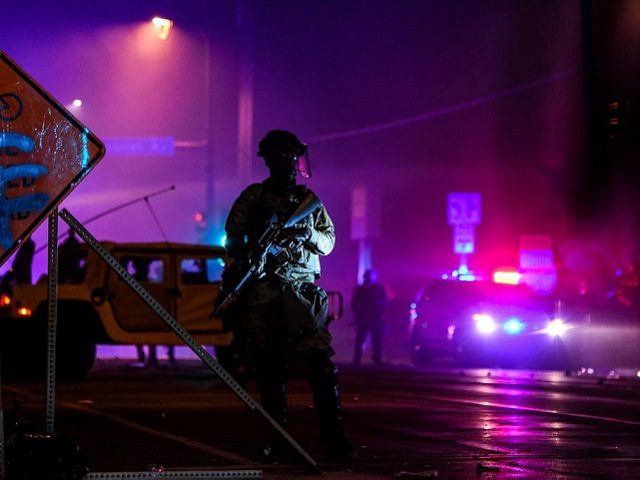American officials and police may be turning Minneapolis into a new Somalia, according to Somali immigrants showcased in a New York Times article.
“The cavalier way that Derek Chauvin pressed his knee on Mr. Floyd’s neck for almost nine minutes and the aggressive crackdown on protesters are … reminders of the incremental abuses of power that eventually led to the breakdown of civil society back home,” the newspaper reported June 7.
“‘I couldn’t distinguish between being in Somalia and being in St. Paul,’ said Omar Jamal, 45, who works in a sheriff’s office in St. Paul and who came to the United States in 1997,” the NYT said, continuing:
Now, “seeing military on the streets, there is only one question that crosses my mind,” he said. “When are they going to start shooting? I’ve seen this before. It’s very scary, and it’s very depressing.”
No native-born Minnesotans are quoted in the article by the NYT reporter Kimiko de Freytas-Tamura. The Paris-born reporter downplayed the city’s crime rates, the recent looting, and instead spotlighted claims by Somali immigrants.
The NYT also invited an aspiring Somali politician to blame city officials for the recent riots and looting:
Suud Olat, 29, who is running for a seat on the Minneapolis City Council, arguing that the city has neglected the needs of its immigrant community.
[…]
“As a refugee, I resettled here, and now I see this place is burning. I see the patterns,” he said, quoting a Somali saying that only he who has his fingers burned has the knowledge to talk about pain.
In December 2019, the NYT posted this report of Somalia’s 29-year civil war:
MOGADISHU, Somalia — An explosives-laden truck blew up at a busy intersection in the Somali capital on Saturday and killed at least 79 people, the latest sign of resurgent militant activity in a country plagued by an enduring strain of violent extremism.
[…]
Beset by strife and chaos since the dictator Siad Barre was ousted in 1991, Somalia has become a byword for chronic state collapse, torn between a stew of rapacious, heavily armed militias and, for a time, linked to piracy on the high seas. Several international attempts to stabilize the country ended in abject failure, and its people have suffered seemingly endless miseries.
In 2018, MinnPost.com reported that 15 percent of Somalis in the state were unemployed, and only half of Somalis in the state had an income above $20,600. A small share earn college degrees, according to the MinnPost.com article.
At least 57,000 Somalis live in Minnesota, not counting the U.S. citizens born to Somali migrants. Nearly all Somalis are Muslims.
The June NYT article repeatedly suggested Minneapolis police mistreat people with a Somali background, but offered thin evidence:
“Mr. [Omar] Jamal has been working with Somali youths who complain to him about being police targets because of their skin color,”
“They say that even if the sky falls, nobody listens to them. They feel irrelevant, they feel insignificant, and that’s why they’re in the streets.”
Jamal has his own perspective as a go-between the city’s police force then the population of young Somalis in the city.
The NYT article did offer some data suggesting excessive police enforcement, saying:
Even before Mr. Floyd’s killing unleashed protests across the nation, Somali men in Minneapolis and elsewhere in Minnesota were part of the population most likely to be in conflict with the police. According to the city’s own figures, about 20 percent of Minneapolis’s population of 430,000 is black. But nearly 60 percent of people who are subjected to police violence — kicks, neck holds, punches, shoves, Mace, Tasers or other forms of force — are black.
Since 2015, the Minneapolis police have documented using force about 11,500 times. For at least 6,650 acts of force, the subject of that force was black. By comparison, the police have used force about 2,750 times against white people, who make up about 60 percent of the population. That means the police used force against black people at a rate at least seven times that of white people in the past five years.
However, the NYT was silent about the other side of the equation. But the state-wide crime rates can be read in the city’s left-wing newspaper, the Star Tribune which reported in April 2016:
As shown in the chart below, only about 6 percent of Minnesotans are black, according to 2014 census estimates. Yet nearly 37 percent of the state’s prison population is black. American Indians make up about 1 percent of the population and more than 9 percent of prisoners.
It’s not a new problem. In 1990, black people made up about 2 percent of the state’s population and 20 percent of people in Minnesota convicted of felonies. By the 2000 census, the black population increased, now accounting for nearly 4 percent of Minnesotans — but 28 percent of the state’s convicted felons and 36 percent of prisoners.
The NYT published a brief biography of the NYT reporter: “Born and raised in Paris, she speaks Japanese, French, Spanish and Portuguese. She is a graduate of the University of Pennsylvania and earned a master’s degree in financial journalism from City University in London.”
The article was posted on the same day that NYT’s op-ed editor departed the newspaper. He left following amid protest by NYT staff against this decision to post an article by Sen. Tom Cotton, R-Ark.

COMMENTS
Please let us know if you're having issues with commenting.